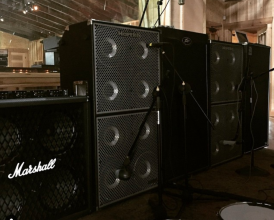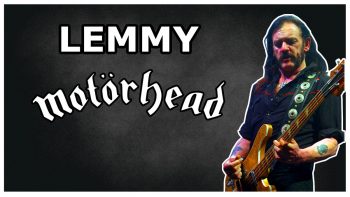David Ellefsons amplifiers and effects pedals – Megadeth (2/2)
Welcome back to part 2 of David Ellefsons amplifiers rig. We finish this series with a look at the amplifiers used in Megadeth and Dave’s effects pedals.
Did you watch the video?! Would you like to know when the next one is out?
David Ellefsons amplifiers prior to Megadeth
When Dave first got his bass guitar – the Gibson EB-0*. The accompanying amplifier was a Fender Bassman* with a 12 inch speaker.
Dave moved to LA when he was 18 and made the trip with a couple of friends from Minnesota. After several weeks they all returned back home while Dave stayed to live the dream.
Dave mentions in an interview with Premier Guitar that he took a Roland Cube amp* with him. Stating “That’s how we composed the first two Megadeth records.”
In addition to the Cube amp, Dave also brought a PA system with him. As he learned early on he would struggle to be heard over guitar amps.
In the book More Life With Deth. Dave writes a letter to a friend in Minnesota and describes a recent Megadeth show around the time Kerry King was in the band.
“I have 6 bass cabs, plus Mats 2 Marshall cabs, Mats head and a 200 watt Marshall head. Dave [Mustaine] had 9 heads and 6 cabs … So did Kerry [King] … Believe me it was powerful” More life with Deth
It’s been said that Megadeth and their supporting acts at the time would combine their amplifiers together into one big rig.
David Ellefsons amplifiers recording Peace Sells
For the recording of both Peace Sells* and Killing Is My Business*. Dave comments that he used an Ashly preamp into AB power amps but doesn’t mention the models used. This is also present in the Peace Sells liner notes.
The notes also mention Ellefson using Decuir bass cabinets with Cerwin Vega speakers. Not much is known about these cabinets as the company is no longer in business .
Bass amplifiers on Killing Is My Business
By May 1986, Megadeth had already released Killing Is My Business and toured a bunch. When Dave first came across the Jackson concert bass he plugged it into a Gallien Krueger 800RB* head with a Hartke 4×10* and a 1×15 XL cabs*.
David Ellefsons amplifiers setup would stay this way through So Far So Good So What*, Rust In Peace*, and Countdown to Extinction*. Becoming the definition of his bass sound. Cabinets were usually configured in 4 or 6 4×10 cabs on both sides of the stage or sometimes all stage right.
Custom Hartke cabinets
Also included in the Countdown to Extinction tour Dave mentions that Hartke sent him some 2x15s. In addition to this on the countdown tour, you can see a pair of early Hartke 3500*’s.
Bass amplifiers on Youthanasia
Following this, the biggest change to David Ellefsons amplifiers comes during the recording of Youthanasia*. Where Dave switches to Ampeg SVT2 pro heads and matching 8×10 cabinets.
Bass amplifiers on Cryptic writings
For Cryptic writings* we see another update with the introduction of a Peavey Kilo head which ran into a pair of Mackie M1400i’s. Dave also describes the recording setup for the album
“I ran the instrument through a Peavey T-Max head into a 1×15″ cabinet I also ran full range into a Peavey KiloBass head and TVX 8×10″ cabinet. Finally, I split the signal into Marty’s Crate 100 watt head and 4×12″ cabinet which added that nice gritty distortion you can hear across the album’s bass tone”
David Ellefsons bass rack on the Risk Tour (1999)
This is a picture of David Ellefsons amplifiers rack at the time. At the top, just out of picture is a Furman power supply.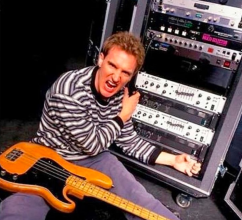
- A Mesaboogie amplifier rack switcher used to switch between cabs should one go down.
- A Samson wireless receiver
- DSP unit or it could be a power amplifier.
- A Whirlwind multi selector to switch basses
- A Sans amp PSA1
- Another Furman
- A Peavey Kilo and Mackie M1400i power amps twice
Dave addresses this change directly by posting this photo on his Instagram. It was taken around 1999 on the Risk tour. He goes on to say the say Peavey heads utilized digital technology in the power section and if you drive them too loud they shut down into safe mode to prevent damage.
David Ellefsons amplifiers during the Risk Tour (1999)
From the power amps the signal goes into 4 Peavey 8×10 TVX’s. Dave describes the Mackies as “musical” and “incredibly loud” The Sans amp was sent to front of house via a DI.
Amplifiers used in the Megadeth break
Dave confirmed the use of this rig during 2001 and it can also be seen on the Rude Awakening DVD*. With the Peavey 8x10s underneath the Marshall cabs.
He then continued to use Peavey amplifiers and cabinets during the Megadeth break. During F5 performances you can see the Peavey 8×10. Which were powered by the Peavey Max 700 heads.
Towards the end of his break in 2009. Dave performs with HAIL! And on stage is a Ashdown MAG 4×10 combo* with a second 4×10 cab underneath.
Megadeth reunion and Rust In Peace anniversary tour (2010)
Dave knew he was going to take part in the Rust in Peace anniversary tour and his plan was to capture the original Rust in Peace tone. Through the use of his Jacksons and Hartke Hydrive* amplifiers.
Originally he used the Hartke LH1000* plugged into a brand new Hydrive 8×10 cabinet. If you look at the Samson website – parent company of Hartke amps. They state Dave was using 8x10s as early as 2010.
However, depending on when you see him. He could be could be using up to six 4x10s or three 8x10s. As pictured here in 2012.
The original Hartke cabs back in the 80’s had aluminium speaker cones. While the new Hydrives boast both paper and aluminium cones.
Dave also specifies that one stack has the tweeter turned on and the second turned off as not to over do it with the high end. He also described his thought process in building his tone.
“The Megadeth guitar tone is built on the sound of Marshall amps, which is very thick in the midrange.
To work with that, I developed a sound using active pickups and very modern, high-tech amplification, which put a really big wallop on the bottom end.
I also added a very clicky, noticeable presence to my treble frequencies. So I almost scooped the midrange completely.
For me, the combination of Jackson basses and Hartke amplifiers really delivers what I need. I have my own bit of real estate in the sonic spectrum of Megadeth.”
Around mid 2013 Dave upgrades his LH1000 to the Hartke Kilo. No specific reason has been given. But compared the LH1000 the Kilo has all the bells and whistles.
Hartke Hydrive HD in 2017
Hartke then released the Hydrives HD* around 2017. These cabs are an im
provement to Hydrives of the past. Boasting an “optimized ferrite magnet assembly and steel chassis design to deliver a maximum power-to-weight ratio”.
They’re also lighter in comparison and Dave goes on to use the HD’s and the Kilo right into the present day. The only footnote to this section is during both past and recent Megadeth recording sessions.
Bass amplifiers in recent Megadeth records
During the recording of Dystopia* in 2015, this picture was released on Dave’s Instagram. It shows the Hartke Hydrives, Peavey VB 8×10 and Ampeg 8×10. Also seen on the far left is a Dave Mustaine Marshall 4×12 signature cab.
Premier guitar also report that Dave used an Ampeg CL* during this period Recent pictures have been released of Megadeth in the studio summer 2019. Here you’ll find Dave with;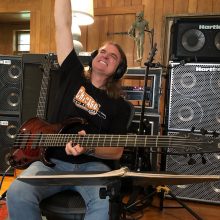
- Two Hartke 4x10XL’s .
- Peavey VB 8×10
- Two Hydrive 4x10s*
- Another 2x10XL* on top.
- And again a Dave Mustaine signature Marshall.
In his rack you can see a pair of Hartke LH1000*’s and an Ampeg SVT3 pro.
David Ellefsons Effects pedals
Effects pedals probably isn’t the first thing that comes to mind when you think of David Ellefson. However you’ll be surprised to hear he’s used a handful over the years. One of the earliest instances I’ve come across was from 1995 in my friend Rons letter.
“The Roland 1 Octave Keyboard pedal triggers a Proteus sound emulator for parts in several of the songs.”
Dave explains this is so he could “ emulate the special effects on the record.” Typically Roland octave pedals refer to a PK6. As the Proteus has a only has a midi input it’s believed it could have been controlled with a Roland PK6 instead.
David Ellefsons Chorus Pedals
Speaking in an interview with Mitch Lafon, Dave admits.
“The only part of the live show I use any effect at all is Dawn Patrol and Poison Is The Cure. I only use a chorus pedal for those exact moments. I really don’t use an effect for anything else. But I have been toying with distortion for that riff in fatal illusion”
As a result of these riffs, a number of Chorus typed pedals have been through Dave’s rig. For the Rust In Peace reunion in 2010 he was sporting a DigiTech CR7* or sometimes an MXR flanger* depending on his preference at the time.
At the same time this interview was published back in 2010. The Jim Dunlop website posted that Dave was using an MXR Stereo Chorus* and an MXR Bass DI*. This is the only reference where either of these pedals are mentioned.
Errors on the Jim Dunlop site
Dunlop have also listed Dave using the wrong plectrum size. A 50 mm pitch black*. But considering that Dave said in Dunlops own video listed below – that he uses Dunlop Green .88*’s. I would take this with a pinch of salt
David adds more Chorus pedals
Premier guitar also reports Dave using a Providence Anadime Bass Chorus* around 2016. Other chorus pedals in recent years have included the Dawn Patrol pedal by Pro Tone and was released in Spring 2017.
This particular pedal was created to retain the bottom end when engaged. As most pedals tend to suck the tone right out of it.
David Ellefson and Overdrive
Dave mentioned, he has been playing with overdrive. One of the earliest instances of this was using a Sans amp PSA1 back around 1999. It has since been upgraded to the Sans amp RBI* as seen in recent recording pictures. Something a bit more permanent is the Dual Bass Station made by Providence*. Dave explains;
“ It adds that really crisp tone, that high-end component I have on ‘Countdown to Extinction’ record. That’s just kind of a general tone enhancer, I don’t really think of it as a pedal, it’s kinda on all the time during live shows.”
You can see it sitting off stage in this clip alongside the stereo chorus.
KHDK in Metal Allegiance
In 2017 Dave posted that he was using a KHDK Abyss Bass Overdrive* with Metal Allegiance*. After several more months, KHDK created his very own custom Fallout Bass Overdrive
Pedals in side projects
Apart from pedals in Megadeth, Dave does use a handful in his side projects. The Hartke Bass Attack* has also seen use in the studio and bass clinics. As Dave admits he doesn’t use it live with Megadeth.
David Ellefsons new pedals
The only news regarding pedals comes from 2018 with the first hint at a David Ellefson Beta DSP*. From their website “the BETA BASS DSP;
Is a Floor controlled Bass guitar system with a fully programmable super precision digital Bass preamp with Studio quality effects.”
David Ellefsons bass strings
Dave’s been through a bunch of string producers. Initially back in the 80’s he was using Rotosound before trying Dean Markley strings.
- Rotosound Swing Bass set** (45-65-85-105)
- Dean Markley strings** (45-65-85-105)
By the end of the 90’s Dave and the band would be using D’addario with a set that is no longer in trade.
For the return to Megadeth in 2010 Dave plays with SIT or Stay in tune strings. He also mentions that they created a David Ellefson signature SIT* set* for him at this time. Comprising of 45-128 and are available to buy online.
David Ellefsons bass pickups
For the most part Dave’s basses were stock. Changes came about during the BC Rich basses where EMG pickups* were used.
In the first wave of Jacksons used from 1987 to 1994. All had proprietary active electronics and Jackson pickups. The basses that followed, The Mouduli. Fenders deluxes, Jazz, Zodiac 5 string, BC Rich and post 2010 Jackson models. All had active electronics and were fitted with EMGS*. and you’ll still find these fitted today.
Signature David Ellefson pickup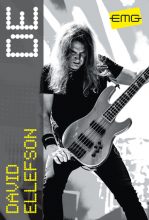
Introduced in January 2019 EMG has released a David Ellefson signature set of pickups*. A dual-coil pickup in the bridge and a ceramic & steel in the neck.
Pickups in the other basses
Taking a look at the vintage Fenders they look like they remain stock and as discussed in David Ellefsons Bass Rig* they used the Aguilar preamp to boost their line signal. The only other exception here is the 4 string Zodiac which was fitted with Bassline pickups – essentially Seymour Duncan*.
David Ellefsons Rack in 2019
This rack was used in 2010 and I’ve heard no news of it changing. The typical rack set up includes
- Furman PL power supply
- Whirlwind MultiSelector
- Shure UR4D*
- Peterson Strobe rack tuner*
- LH1000 amps on the bottom.
The LH1000’s are shown here but they would have been upgraded to the Hartke Kilo
Highmass bridges
The only other accessory Dave uses are high mass bridges. Many of his original basses used the Badass 2 bridge*. From 2010 on wards the Jackson custom shops came with their own proprietary high masses.
In the next Know Your Bass Player
In the next know your bass player. I was thinking of Peter Steele from Typo Negative or Rex Brown from Pantera. Leave me a comment and tell me what you think about that.
Watch more from Know Your Bass Player
Continue watching the most popular bass rig videos .

